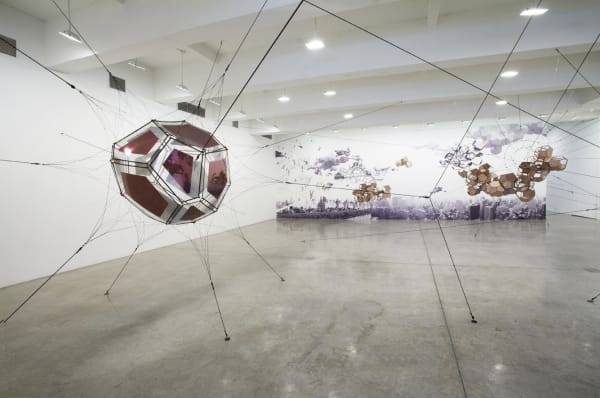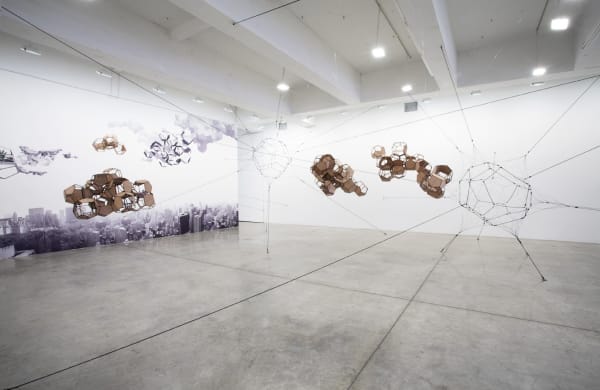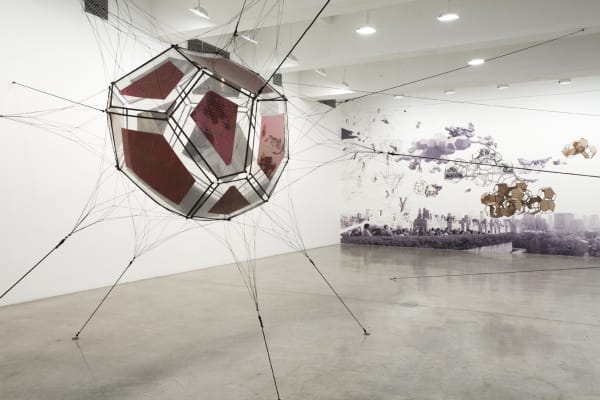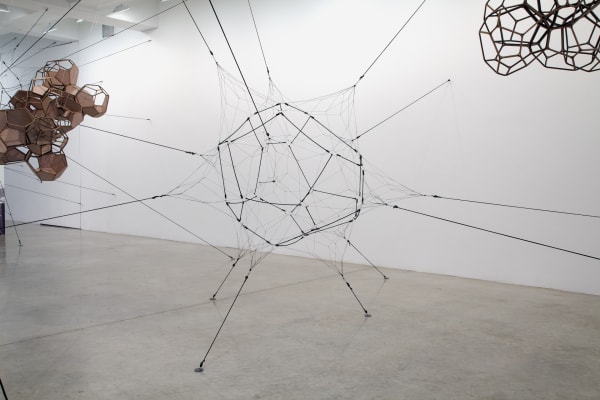Tanya Bonakdar Gallery is pleased to present an important selection of sculpture and installation by Tomas Saraceno. As part of his ongoing Air-Port-City / Cloud-City project, Saraceno will fill the downstairs gallery space with sprawling architectural proposals, experiments and models that explore the possibility of a future airborne existence – a literal "cloud city." Informed by the worlds of art, architecture, natural sciences and engineering, his floating sculptures and environmental installations invite viewers to consider geometries and phenomena of the natural world as adaptable models for the ways we live and interact. The gallery is delighted to exhibit this work alongside the artist's current Cloud City installation on the roof of the Metropolitan Museum of Art, his first major commission in the United States.
Building on the progressive proposals and theories put forth by visionary architects before him including R. Buckminster Fuller, Gyula Kosice and Yona Friedman, Saraceno's work has long explored new ways of inhabiting our environment. Throughout the past decade, he has collaborated with experts across various disciplines – astrophysics, engineering, botany, architecture and archeology, to name a few – to advance his vision of an Air-Port-City. Set in a permanent state of transformation, these floating metropolises are made up of habitable, cell-like platforms powered by solar energy. Together they migrate and recombine as freely as clouds themselves, reimagining borders as more elastic and dynamic. Built and sustained by a network of people united by "cloud citizenship," Saraceno suggests a new, collective territory in the air that becomes, in his words, "a three-dimensional era of social engagement."
Set against a floor-to-ceiling digital rendering of his vision in the sky, a series of hanging sculptures hover throughout the entryway and main gallery as tangible models of these floating cities. The 120 individual units comprising these works are based on the complex three-dimensional geometry of the Weaire-Phelan model, an idealized foam structure representing the perfect packaging of spheres with minimal surface and maximum volume. Magnifying these molecular structures to visible proportions, Saraceno combines them into constructions of various shapes and sizes, and demonstrates their ability to endlessly reconfigure. It is the adaptability and mobility of these units that serve as the cornerstone for Saraceno's vision. From small-scale models to life-size interactive environments, each realization of this project is an invitation for viewers to conceptualize – and at times physically experience – new ways of living and interacting with one another and with the environment at large.
Saraceno furthers these notions of interconnectivity through his interactive "biosphere" installations. Inspired by the membrane construction and precise geometry of spider webs, the artist carefully adapts these patterns to create his
own webs of networks and spheres at an architectural scale. In the two-part Biospherical work presented in this show, he shapes webbed globes using thin black cords and elastic connectors anchored to various points along the room's ceiling, floor and walls. As viewers navigate these installations, radiating ropes and connection points force them to reconsider their own understanding of the physical space as well as its inherent interconnections; with every touch of a cord, a single reverberation ripples throughout the entire network. Beyond their physical presence, these sculptures also seek to connect disparate realms of existence and knowledge through their various associations, which range from microscopic phenomena of spider web membranes and neuronal synapses within the brain to macroscopic networks of cyberspace and the cosmos.
All installation images above: Photo by Jean Vong






